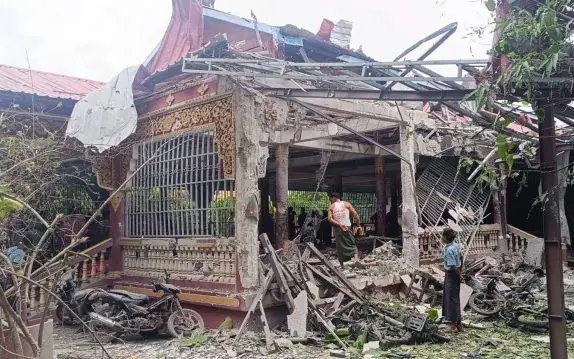At least 24 people have been killed and 47 others injured after Myanmar’s military dropped two bombs from a motorised paraglider onto a crowd during a Buddhist festival, according to a spokesperson for the country’s government-in-exile, who spoke to BBC Burmese.
The deadly assault took place on Monday evening in Chaung U township, located in central Myanmar’s Sagaing region, where around 100 civilians had gathered to celebrate a national holiday and hold a peaceful demonstration against the country’s military government.

Myanmar has been in the grip of a civil war since 2021, when the army overthrew the democratically elected government of Aung San Suu Kyi, sparking nationwide armed resistance.
Since then, thousands have died and millions have been displaced, as ethnic militias and civilian resistance forces fight to end military rule.
Although the junta has lost control of more than half the country, recent months have seen it regaining ground through an intensified campaign of airstrikes and heavy artillery bombardment — actions that have drawn widespread condemnation from international observers.
The Sagaing region, where Monday’s strike occurred, has long been a stronghold of anti-junta resistance. Much of the area is controlled by People’s Defence Force (PDF) militias — civilian volunteer groups formed after the coup — which also manage local governance in areas outside military control.
An official from the local PDF told BBC Burmese that they had received intelligence about a possible airborne attack during the festival and tried to end the event early.
However, the paramotors — lightweight aircraft equipped with engines and parachute wings — arrived sooner than expected.
“It all happened in seven minutes,” the official said, adding that his leg was injured in the blast and that several people standing near him were killed instantly.

Eyewitnesses described horrifying scenes in the aftermath.
Local residents said that many bodies were unrecognisable, and children were among the dead.
“Children were completely torn apart,” a woman who helped organise the festival told AFP news agency. Although she was not present during the attack, she attended funerals on Tuesday and said rescuers were still “collecting body parts” from the site.
Amnesty International condemned the assault, saying the junta’s use of motorised paragliders to target civilians marks a “disturbing new trend.”
A recent BBC Burmese report revealed that Myanmar’s military has increasingly turned to paramotors due to a shortage of aircraft and helicopters, a consequence of international sanctions that have limited its access to foreign military supplies.
Despite this, analysts note that the junta continues to benefit from advanced drones and military technology supplied by China and Russia, which have given it a renewed battlefield advantage.
Amnesty’s Myanmar researcher, Joe Freeman, called the strike “a gruesome wake-up call,” urging immediate international action.
“Civilians in Myanmar need urgent protection,” he said, calling on the Association of Southeast Asian Nations (Asean) — due to meet later this month — to “increase pressure on the junta and rethink an approach that has failed the Myanmar people for almost five years.”

Monday’s gathering had begun as a peaceful candlelight vigil opposing the junta’s mandatory conscription policy and the planned national elections.
Participants also called for the release of political prisoners, including Aung San Suu Kyi, who remains imprisoned after being deposed during the coup.
Myanmar’s military authorities have announced plans to hold general elections in December — the first since the 2021 takeover. However, critics dismiss the poll as a sham, arguing that it is designed solely to legitimise continued military rule.
Many opposition groups have been banned, and experts predict that voting will occur only in military-controlled areas, which make up roughly half the country.
As the conflict grinds into its fourth year, attacks like Monday’s underscore the military’s growing reliance on air power to crush resistance — and the devastating toll this strategy continues to exact on civilians.
The massacre in Chaung U stands as yet another tragic reminder that, in Myanmar’s war-torn heartland, even a religious festival can become a battlefield.




